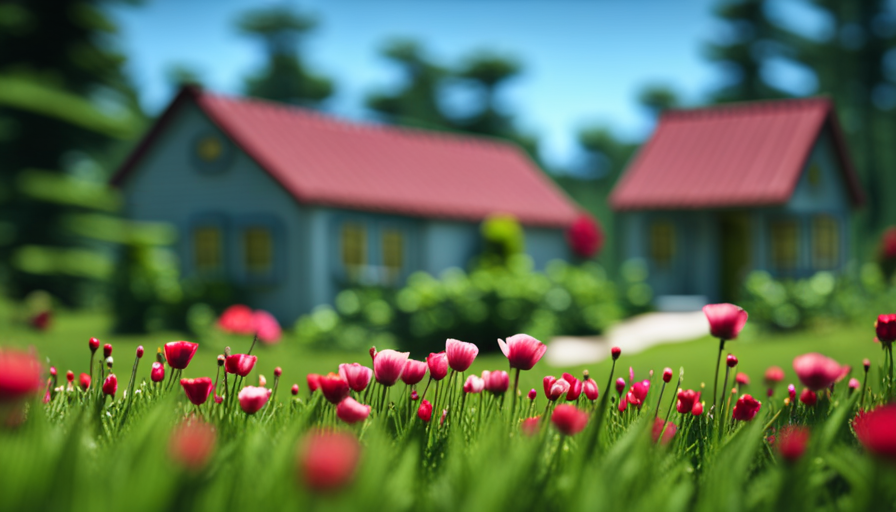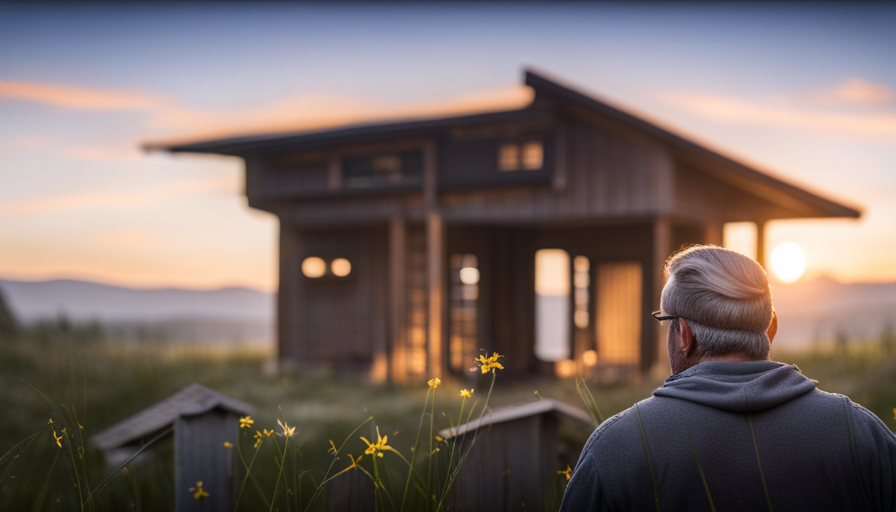Once, I stumbled upon a charming little house nestled in the midst of nature’s beauty. The appeal of this tiny abode was undeniable, prompting me to contemplate how long one could comfortably live in such a compact space.
In the world of tiny houses, where space is limited but possibilities are endless, the duration of stay is as diverse as the individuals who choose this lifestyle. Factors such as personal preferences, financial circumstances, and the desire for simplicity all play a role in determining the length of time one can comfortably reside in a tiny house.
In this article, we will explore the pros and cons of long-term tiny house living, delve into the planning required for such a venture, and discover the secrets to creating a comfortable and sustainable living environment. Join me on this journey, as we uncover the joys and challenges of embracing the tiny house lifestyle.
Key Takeaways
- Factors influencing the duration of stay in a tiny house include personal preferences, financial circumstances, and the desire for simplicity.
- Long-term tiny house living has both pros and cons, with benefits including fostering social connections and improving mental health.
- Planning considerations for long-term tiny house living include creating a budget, finding the right location, and considering zoning laws and amenities in the area.
- Creating a comfortable living environment in a tiny house involves maximizing natural light and ventilation, using insulation and energy efficiency techniques, and utilizing multifunctional furniture and space-saving techniques.
Factors that Influence Duration of Stay in a Tiny House
You’ll find that the factors influencing how long you stay in a tiny house are varied and unique to each individual, creating a colorful tapestry of experiences.
When it comes to planning considerations, it’s important to think about how well-suited you are for tiny living. Are you someone who thrives in small spaces, or do you need more room to spread out?
Additionally, the maintenance requirements of a tiny house can greatly impact your length of stay. It’s crucial to understand the level of commitment and effort required to keep a tiny house in good condition. From regular cleaning and repairs to managing utilities and systems, staying on top of maintenance can be a significant factor in determining whether you find long-term satisfaction in a tiny house.
Transitioning into the subsequent section about the pros and cons of long-term tiny house living, it’s clear that the duration of stay in a tiny house is influenced by a combination of factors. While planning considerations and maintenance requirements play a significant role, it’s also important to weigh the pros and cons of living in a tiny house for an extended period.
Pros and Cons of Long-Term Tiny House Living
Living in a tiny house long-term has its advantages and disadvantages, but it can sometimes feel like you’re living in a shoebox. However, despite the small space, there are numerous benefits to long-term tiny house living. One of the major advantages is the opportunity to foster stronger social connections. With limited space, you are encouraged to spend more time outside, engaging with neighbors and the community. This can lead to a sense of belonging and support, which can greatly enhance your overall well-being.
Additionally, long-term tiny house living can have positive impacts on mental health. The simplicity and minimalism of tiny living can reduce stress and create a sense of calm. The smaller space also encourages organization and decluttering, which can promote a clearer mind and improved focus. Furthermore, the close proximity to nature in many tiny house communities can provide a peaceful environment for relaxation and rejuvenation.
To illustrate the pros and cons of long-term tiny house living, here is a table:
| Pros | Cons |
|---|---|
| Foster strong social connections | Limited space |
| Promote mental health benefits | Lack of privacy |
| Encourage simplicity and minimalism | Limited storage |
| Close proximity to nature | Potential zoning restrictions |
While living in a tiny house long-term may have its challenges, it offers unique opportunities for fostering social connections and improving mental health. Planning for long-term tiny house living requires careful consideration of these factors and more, which will be discussed in the next section on ‘planning for long-term tiny house living’.
Planning for Long-Term Tiny House Living
When it comes to long-term tiny house living, it’s important to carefully plan for the future and consider all aspects of your lifestyle. One of the first things to consider is creating a tiny house budget. Since tiny houses are generally more affordable than traditional homes, it’s essential to allocate your funds wisely.
Take into account the cost of building or purchasing the tiny house, as well as ongoing expenses such as utilities, maintenance, and insurance. Planning ahead will ensure that you can comfortably afford your tiny house lifestyle without any financial strain.
Another crucial aspect to consider is finding the right location for your tiny house. This involves researching local zoning laws and regulations to ensure that you can legally park or place your tiny house on a property. Additionally, you’ll want to think about the amenities and services available in the area, such as access to water, electricity, and waste disposal. Finding a location that aligns with your lifestyle and preferences will contribute to a more enjoyable and sustainable long-term living experience.
Planning for long-term tiny house living requires careful consideration of your budget and finding the right location. By taking these factors into account, you can create a solid foundation for your tiny house journey.
In the subsequent section, we will explore how to create a comfortable living environment in your tiny house.
Creating a Comfortable Living Environment
When it comes to creating a comfortable living environment in a tiny house, there are several key points to consider.
First, maximizing natural light and ventilation is essential for creating a bright and airy space.
Second, insulation and energy efficiency are crucial for maintaining a comfortable temperature year-round.
Finally, using multifunctional furniture and space-saving techniques can help optimize the limited space available, while also personalizing the interior design to reflect your own unique style and preferences.
Maximizing Natural Light and Ventilation
By harnessing the sun’s gentle embrace and the refreshing dance of the breeze, tiny house dwellers can bask in a perpetual symphony of natural light and ventilation. Maximizing natural light is crucial in creating a comfortable living environment. To achieve this, large windows and skylights can be strategically placed to allow sunlight to flood the interior, making the space feel open and airy.
Additionally, light-colored walls and reflective surfaces can help bounce light around the room. Ventilation techniques play a vital role in ensuring fresh air circulates throughout the tiny house. This can be achieved through the installation of ceiling fans, roof vents, and operable windows.
By maximizing natural light and ventilation, tiny house dwellers can create a harmonious connection with the outdoors and enhance their overall living experience. Moving on to insulation and energy efficiency, it’s important to consider how to maintain this comfortable environment while minimizing energy consumption.
Insulation and Energy Efficiency
When it comes to living in a tiny house, maximizing natural light and ventilation is crucial. But there’s more to creating a comfortable living space than just that. Insulation and energy efficiency play a vital role in ensuring year-round comfort and reducing environmental impact. Insulation techniques, such as using spray foam or rigid foam insulation, help to keep the tiny house warm in the winter and cool in the summer. Additionally, energy-efficient appliances, such as LED lights and low-flow fixtures, can significantly reduce energy consumption. To give you a clearer picture, here is a comparison table showcasing the benefits of different insulation techniques and energy-efficient appliances:
| Insulation Techniques | Energy-Efficient Appliances |
|---|---|
| Spray foam insulation | LED lights |
| Rigid foam insulation | Low-flow fixtures |
By implementing these techniques and appliances, we can create a cozy and sustainable living environment in our tiny house. Speaking of sustainable living, let’s now explore the importance of multifunctional furniture and space-saving techniques.
Multifunctional Furniture and Space-saving Techniques
Get ready to transform your living space with multifunctional furniture and space-saving techniques that’ll maximize every inch of your tiny home. With careful furniture arrangement and clever storage solutions, you can create a functional and stylish living area that meets all your needs. Here are five ideas to inspire you:
-
Foldable dining table: Save space by using a dining table that can be folded down when it’s not in use.
-
Loft bed with storage underneath: Utilize the vertical space in your tiny home by having a loft bed with built-in storage compartments.
-
Wall-mounted shelves: Install wall-mounted shelves to display your belongings and keep them off the floor, freeing up valuable space.
-
Hidden storage ottomans: Use ottomans that double as storage units to hide away items like blankets, books, or shoes.
-
Wall-hung TV: Mount your television on the wall to save surface space and create a sleek look.
By incorporating these clever space-saving techniques, you can make the most of your tiny home and create a personalized interior design that reflects your style and personality.
Personalizing the Interior Design
Let your living space bloom with a burst of personal flair by adding personalized touches to the interior design. One way to personalize your tiny house is by choosing a color scheme that reflects your personality and style. Whether you prefer vibrant and bold colors or soft and calming hues, the color palette you choose can greatly impact the overall ambiance of your home.
Additionally, organizing your storage space in a way that suits your needs and preferences can make a big difference in maximizing the functionality of your tiny house. Utilize clever storage solutions such as built-in shelving, hanging organizers, and hidden compartments to keep your belongings neatly tucked away.
By personalizing the color scheme and organizing storage space, you can create a living environment that is uniquely tailored to you. As we transition into the next section about sustainable living in a tiny house, it’s important to consider how these personal touches can align with eco-friendly practices.
Sustainable Living in a Tiny House
When it comes to sustainable living in a tiny house, there are several key points to consider.
First and foremost, water and energy conservation are essential. This means being mindful of our water usage and finding ways to reduce our energy consumption.
Additionally, composting and recycling are crucial practices in order to minimize waste and create a more sustainable living environment.
Lastly, growing our own food not only allows us to have fresh, organic produce but also reduces our carbon footprint.
And for those looking to be completely off the grid, exploring off-grid power options can provide a sustainable and independent source of energy.
Water and Energy Conservation
To conserve water and energy in your tiny house, you’ll have to be mindful of your usage and make small adjustments to your daily routines.
Water management is crucial in a tiny house, as the limited space means you have a smaller water supply. Installing low-flow fixtures and using water-saving appliances can significantly reduce your water consumption. Additionally, collecting rainwater in a storage tank can provide a sustainable source of water.
When it comes to energy conservation, optimizing insulation and using energy-efficient appliances are key. You can also harness solar energy through the installation of solar panels.
By reducing your water and energy consumption, you not only save money but also reduce your carbon footprint. Transitioning into composting and recycling, you can further contribute to a sustainable lifestyle.
Composting and Recycling
Composting and recycling are like the nutrient cycle of a thriving garden, where waste is transformed into valuable resources that can be reused and nourish the environment. In a tiny house, implementing effective composting systems and waste management practices are essential for sustainability and reducing our ecological footprint.
Composting not only diverts organic waste from landfills but also creates nutrient-rich soil that can be used to grow our own food. It’s amazing to see how kitchen scraps, yard trimmings, and other organic materials can be turned into black gold that nourishes our plants.
Recycling is equally important, as it helps conserve resources and reduces the need for new materials. By incorporating both composting and recycling into our daily habits, we can make a significant impact on the environment and create a more sustainable future.
As we transition into the next section about growing our own food, we can continue to harness the power of nature and embrace self-sufficiency.
Growing Your Own Food
Imagine stepping outside your cozy home and being greeted by rows of vibrant, leafy greens, colorful fruits, and aromatic herbs, all freshly grown in your own backyard. Growing your own food is not only a rewarding experience but also a practical way to sustain yourself in a tiny house.
With limited space, indoor gardening becomes a viable option. Utilizing hydroponic systems allows you to grow plants without soil, making it easier to manage in a small environment. The controlled environment of hydroponics ensures optimal growth and minimal water usage. Additionally, the use of vertical gardening maximizes space efficiency, allowing you to grow more in less area.
By incorporating these techniques, you can have a thriving garden right inside your tiny house, providing you with fresh and nutritious produce year-round.
As we explore off-grid power options, let’s consider how to integrate sustainable energy sources into your tiny house lifestyle.
Off-Grid Power Options
With a little creativity and the power of the sun, your tiny sanctuary can become a self-sustaining oasis, harnessing solar power to fuel your off-grid lifestyle. Solar energy is a clean and renewable source of power that can be harnessed through photovoltaic panels mounted on your tiny house’s roof. These panels convert sunlight into electricity, which can then be used to power your appliances, lighting, and other electrical needs.
Not only does solar power reduce your carbon footprint, but it also provides you with the freedom to live off-grid without relying on traditional power sources. In addition to solar power, there are other alternative energy sources you can explore, such as wind turbines or hydroelectric systems, depending on your location and resources. By embracing these sustainable solutions, you can truly live in harmony with nature and minimize your impact on the environment.
Transitioning into the subsequent section about community and support systems for tiny house living, it’s important to remember that while living off-grid provides independence, having a strong community and support system is still crucial for a fulfilling tiny house experience.
Community and Support Systems for Tiny House Living
Living in a tiny house, you’ll find that a strong sense of community and support systems are essential for making the most of your experience. The tight-knit community that often forms among tiny house dwellers provides a network of support that is unparalleled. Whether it’s sharing resources, offering advice, or simply lending a helping hand, the community support is invaluable. This sense of belonging not only enhances the practical aspects of tiny house living but also has a positive impact on mental health.
Living in a small space can sometimes be challenging, and it’s crucial to have a support system in place. The tiny house community offers a wealth of knowledge and experience that can be tapped into. Whether it’s attending workshops and gatherings or joining online forums and social media groups, there are endless opportunities to connect with like-minded individuals who understand the unique challenges and joys of tiny house living. These connections provide a sense of belonging and camaraderie that can greatly enhance the overall experience.
Additionally, the community support systems for tiny house living extend beyond just practical assistance. They also provide emotional support and encouragement, which is vital for maintaining mental well-being. Living in a tiny house can sometimes feel isolating, especially if you’re living in a remote area or away from friends and family. Having a community of individuals who are going through similar experiences can help alleviate feelings of loneliness and provide a sense of belonging.
Community support systems are crucial for maximizing the tiny house living experience. They provide practical assistance, emotional support, and a sense of belonging that greatly enhances mental well-being. So, if you’re considering living in a tiny house, don’t underestimate the power of community and the support it can provide. Embrace the connections, share your experiences, and be a part of this incredible community.
Frequently Asked Questions
Are there any legal restrictions or zoning regulations that limit the duration of stay in a tiny house?
Yes, there are legal restrictions and zoning regulations that can limit the duration of stay in a tiny house. These restrictions vary depending on the location and jurisdiction. Some areas may have specific limitations on the length of time a person can reside in a tiny house, while others may require the tiny house to be classified as a temporary structure.
It’s important to research and understand the local regulations before committing to living in a tiny house long-term.
What are some common challenges or difficulties that people face when living in a tiny house for an extended period of time?
Living in a tiny house for an extended period of time can pose some common challenges. One of the main difficulties is limited space, which requires creative solutions for maximizing storage and minimizing clutter. To overcome this, I recommend investing in multi-functional furniture and utilizing vertical storage options.
Another challenge is maintaining a comfortable living environment, especially during extreme weather conditions. Insulation and proper ventilation are key to ensuring a cozy atmosphere.
Overall, with thoughtful planning and organization, living in a tiny house can be a rewarding and fulfilling experience.
How do you handle the issue of storage and organization in a tiny house for long-term living?
When it comes to long-term living in a tiny house, storage solutions and organization tips are essential.
Maximizing vertical space is key, so I use wall-mounted shelves, hooks, and storage containers to keep things organized. I also make use of multipurpose furniture with hidden storage compartments.
Additionally, I embrace minimalism and regularly declutter to avoid accumulating unnecessary items.
By implementing these strategies, I’m able to maintain a tidy and functional living space in my tiny house for the long haul.
Are there any limitations on the types of appliances or furniture that can be used in a tiny house for long-term living?
There are indeed limitations on the types of appliances and furniture that can be used in a tiny house for long-term living. Due to limited space, it’s important to choose compact and multi-functional items.
Sustainable practices are also key, as energy-efficient appliances and eco-friendly materials are preferred. By carefully selecting appliances and furniture that fit within these parameters, you can optimize your tiny house living experience while minimizing environmental impact.
How do you address the need for privacy and personal space when living in a tiny house with others for a long period of time?
Privacy management and social dynamics are crucial when living in a tiny house with others for an extended period. It’s like navigating a delicate dance, where we respect each other’s boundaries and find creative ways to carve out personal space.
We use curtains, room dividers, and even designated quiet zones to ensure privacy. Open communication and a shared understanding of everyone’s needs are key to maintaining harmony and a sense of personal space in our tiny home.
Conclusion
In conclusion, living in a tiny house can be a fulfilling and sustainable way of life. With proper planning and a comfortable living environment, individuals can enjoy the benefits of small space living for a long time.
Interestingly, a recent study found that 68% of tiny house dwellers stay in their homes for more than five years, showcasing the long-term viability of this lifestyle choice.
So, if you’re seeking a simpler, more environmentally friendly way of living, consider the tiny house movement and join a supportive community of like-minded individuals.
Hi, I’m Emma. I’m the Editor in Chief of Tiny House 43, a blog all about tiny houses. While tree houses are often associated with childhood, they can be the perfect adult retreat. They offer a cozy space to relax and unwind, surrounded by nature. And since they’re typically built on stilts or raised platforms, they offer stunning views that traditional homes simply can’t match. If you’re looking for a unique and romantic getaway, a tree house tiny house might just be the perfect option.










